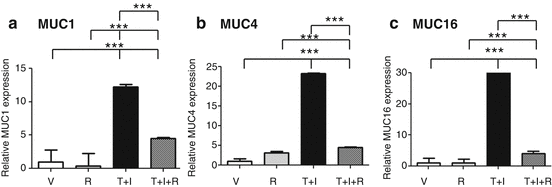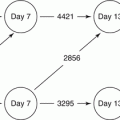Fig. 4.1
Structural representations of TMs. (a) MUC1, MUC4, MUC16 (not drawn to scale). Abbreviations: VNTR variable number of tandem repeats, SEA sea urchin sperm protein–enterokinase–agrin, TMD transmembrane domain, CT cytoplasmic tail, CysD Cys-rich domain, NIDO nidogen homology sequence, AMOP adhesion-associated domain, vWD von Willebrand factor D domain, EGF epidermal growth factor-like regions. (b) Size comparison of MUC1, extending 200–500 nm from the cell surface, and epidermal growth factor receptor (EGFR), 50 nm from the cell surface (drawn to scale)
4.3.2 Functions
4.4 Control of TM Expression
4.4.1 Cytokines
4.4.2 Steroid Hormones
4.4.3 PPARs and Trophoblastic Expression of MUC1
Studies in mice revealed two interesting features of Muc1 expression: (1) that another transcriptional coregulator, Peroxisome Proliferator-Activated Receptor-γ (PPARγ), stimulates Muc1 expression and (2) Muc1 is expressed by placental trophoblast (Shalom-Barak et al. 2004). PPARγ is activated by various natural ligands including certain polyunsaturated fatty acids and prostaglandin J2, as well as the synthetic thiazolidinediones, including rosiglitazone and pioglitazone. Investigation of PPARγ actions in human cell lines revealed an opposite response to that observed in mice, namely, inhibition with regard to both progesterone- (Wang et al. 2010) and EGF-simulated (Dharmaraj et al. 2013) MUC1 expression. The human MUC1 gene has a 21 bp insertion in the PPARγ-responsive region which appears to account for the differences in responsiveness between species. In addition to other actions, PPARγ and its agonists have anti-inflammatory actions (Kapadia et al. 2008). In this regard, PPARγ activators can inhibit cytokine-stimulated expression of all three TMs (Fig. 4.2). Therefore, it appears that TM expression can be regulated coordinately offering opportunities for broad therapeutic control. PPARγ activators have therapeutic value in placental dysfunction, including mitigation of symptoms associated with preeclampsia (McCarthy et al. 2011; Kadam et al. 2015). Whether this has relevance to reduction of trophoblast MUC1 expression is unclear.


Fig. 4.2
Coordinate regulation of TMs by cytokines and rosiglitazone. MCF7 cells were incubated for 48 h with vehicle control (V), rosiglitazone (100 μM; R), TNFα (25 ng/ml) plus IFNγ (200 IU) (T + I), or TNFα plus IFNγ plus rosiglitazone (T + I + R). RNA was extracted from triplicate independent samples in each case for qRT-PCR analyses of (a) MUC1, (b) MUC4, and (c) MUC16 mRNA relative to that of β-actin. *** p < 0.001 V vs. T + I and T + I + R, R vs. T + I and T + I + R
4.4.4 Sheddases
4.5 Transmembrane Mucin Binding Proteins
4.5.1 Galectins
4.5.2 Selectins
4.5.3 Siglecs
4.5.4 Mesothelin
4.5.5 TM Binding Signaling Proteins
4.6 Summary and Future Directions
References
Agrawal B, Krantz MJ, Parker J, Longenecker BM (1998) Expression of MUC1 mucin on activated human T cells: implications for a role of MUC1 in normal immune regulation. Cancer Res 58:4079–4081PubMed
Alijotas-Reig J, Llurba E, Gris JM (2014) Potentiating maternal immune tolerance in pregnancy: a new challenging role for regulatory T cells. Placenta 35:241–248PubMed
Andersch-Bjorkman Y, Thomsson KA, Holmen Larsson JM, Ekerhovd E, Hansson GC (2007) Large scale identification of proteins, mucins, and their O-glycosylation in the endocervical mucus during the menstrual cycle. Mol Cell Proteomics 6:708–716PubMed
Ando Y, Kusano E (1992) [Renovascular hypertension: etiological classification and procedures for diagnosis]. Nihon Rinsho (50 Suppl): 633–639
Angata T, Varki A (2000) Siglec-7: a sialic acid-binding lectin of the immunoglobulin superfamily. Glycobiology 10:431–438PubMed
Argueso P, Guzman-Aranguez A, Mantelli F, Cao Z, Ricciuto J, Panjwani N (2009) Association of cell surface mucins with galectin-3 contributes to the ocular surface epithelial barrier. J Biol Chem 284:23037–23045PubMedCentralPubMed
Bafna S, Kaur S, Batra SK (2010) Membrane-bound mucins: the mechanistic basis for alterations in the growth and survival of cancer cells. Oncogene 29:2893–2904PubMedCentralPubMed
Bancalari A, Herrera A, Rodriguez MS, Pandolfi E, Cantin A (1989) Correlation of clinical, radiologic and pathologic aspects of the thymus in newborn infants. Rev Chil Pediatr 60:135–142PubMed
Baser E, Gungor T, Togrul C, Turkoglu O, Celen S (2014) Preoperative prediction of poor prognostic parameters and adjuvant treatment in women with pure endometrioid type endometrial cancer: what is the significance of tumor markers? Eur J Gynaecol Oncol 35:513–518
Bazer FW, Spencer TE, Johnson GA (2009) Interferons and uterine receptivity. Semin Reprod Med 27:90–102PubMed
Belisle JA, Horibata S, Jennifer GA, Petrie S, Kapur A, Andre S, Gabius HJ, Rancourt C, Connor J, Paulson JC, Patankar MS (2010) Identification of Siglec-9 as the receptor for MUC16 on human NK cells, B cells, and monocytes. Mol Cancer 9:118PubMedCentralPubMed
Berchuck A, Soisson AP, Olt GJ, Soper JT, Clarke-Pearson DL, Bast RC Jr, McCarty KS Jr (1989) Epidermal growth factor receptor expression in normal and malignant endometrium. Am J Obstet Gynecol 161:1247–1252PubMed
Brayman MJ, Julian J, Mulac-Jericevic B, Conneely OM, Edwards DP, Carson DD (2006) Progesterone receptor isoforms A and B differentially regulate MUC1 expression in uterine epithelial cells. Mol Endocrinol 20:2278–2291PubMed
Brayman MJ, Dharmaraj N, Lagow E, Carson DD (2007) MUC1 expression is repressed by protein inhibitor of activated signal transducer and activator of transcription-y. Mol Endocrinol 21:2725–2737PubMed
Brinkman-Van der Linden EC, Varki A (2000) New aspects of siglec binding specificities, including the significance of fucosylation and of the sialyl-Tn epitope. Sialic acid-binding immunoglobulin superfamily lectins. J Biol Chem 275:8625–8632PubMed
Brinkman-Van der Linden EC, Hurtado-Ziola N, Hayakawa T, Wiggleton L, Benirschke K, Varki A, Varki N (2007) Human-specific expression of Siglec-6 in the placenta. Glycobiology 17:922–931PubMed
Carson DD (2008) The cytoplasmic tail of MUC1: a very busy place. Sci Signal 1:35
Carson DD, Bagchi I, Dey SK, Enders AC, Fazleabas AT, Lessey BA, Yoshinaga K (2000) Embryo implantation. Dev Biol 223:217–237PubMed
Carson DD, Julian J, Lessey BA, Prakobphol A, Fisher SJ (2006) MUC1 is a scaffold for selectin ligands in the human uterus. Front Biosci 11:2903–2908PubMed
Cha J, Dey SK (2014) Cadence of procreation: orchestrating embryo-uterine interactions. Semin Cell Dev Biol 34:56–64PubMed
Cha J, Sun X, Dey SK (2012) Mechanisms of implantation: strategies for successful pregnancy. Nat Med 18:1754–1767PubMed
Chapela PJ, Broaddus R, Hawkins SM, Lessey BA, Carson DD (2015) Cytokine Stimulation of MUC4 Expression in Human Female Reproductive Tissue Carcinoma Cell Lines and Endometrial Cancer. J Cell Biochem. doi: 10.1002/jcb.25213. [Epub ahead of print], PMID: 25923310
Chavatte-Palmer P, Guillomot M (2007) Comparative implantation and placentation. Gynecol Obstet Invest 64:166–174PubMed
Chen SH, Dallas MR, Balzer EM, Konstantopoulos K (2012) Mucin 16 is a functional selectin ligand on pancreatic cancer cells. FASEB J 26:1349–1359PubMedCentralPubMed
Choudhury A, Moniaux N, Winpenny JP, Hollingsworth MA, Aubert JP, Batra SK (2000) Human MUC4 mucin cDNA and its variants in pancreatic carcinoma. J Biochem 128:233–243PubMed
Comamala M, Pinard M, Theriault C, Matte I, Albert A, Boivin M, Beaudin J, Piche A, Rancourt C (2011) Downregulation of cell surface CA125/MUC16 induces epithelial-to-mesenchymal transition and restores EGFR signalling in NIH:OVCAR3 ovarian carcinoma cells. Br J Cancer 104:989–999PubMedCentralPubMed
Croy BA, Ashkar AA, Foster RA, DiSanto JP, Magram J, Carson D, Gendler SJ, Grusby MJ, Wagner N, Muller W, Guimond MJ (1997) Histological studies of gene-ablated mice support important functional roles for natural killer cells in the uterus during pregnancy. J Reprod Immunol 35:111–133PubMed
de Bruijn HW, van Beeck C-CT, Jager S, Duk JM, Aalders JG, Fleuren GJ (1986) The tumor marker CA 125 is a common constituent of normal cervical mucus. Am J Obstet Gynecol 154:1088–1091PubMed
DeSouza MM, Mani SK, Julian J, Carson DD (1998) Reduction of mucin-1 expression during the receptive phase in the rat uterus. Biol Reprod 58:1503–1507PubMed
DeSouza MM, Surveyor GA, Price RE, Julian J, Kardon R, Zhou X, Gendler S, Hilkens J, Carson DD (1999) MUC1/episialin: a critical barrier in the female reproductive tract. J Reprod Immunol 45:127–158PubMed
Dharmaraj N, Wang P, Carson DD (2010) Cytokine and progesterone receptor interplay in the regulation of MUC1 gene expression. Mol Endocrinol 24:2253–2266PubMedCentralPubMed
Dharmaraj N, Engel BJ, Carson DD (2013) Activated EGFR stimulates MUC1 expression in human uterine and pancreatic cancer cell lines. J Cell Biochem 114:2314–2322
Edwards DR, Handsley MM, Pennington CJ (2008) The ADAM metalloproteinases. Mol Aspects Med 29:258–289PubMed
Stay updated, free articles. Join our Telegram channel

Full access? Get Clinical Tree






